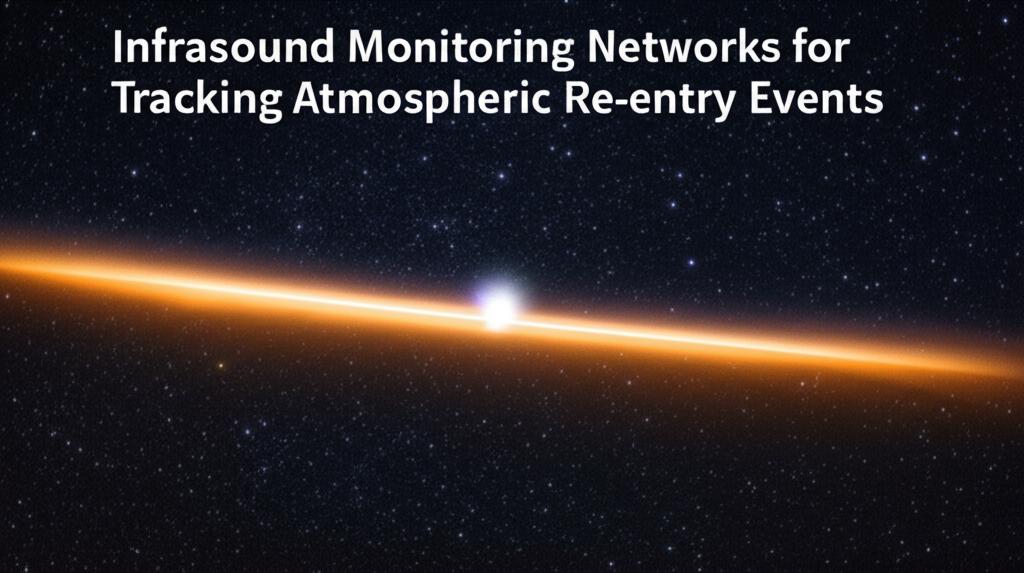Infrasound monitoring networks represent a crucial and evolving technology for observing objects entering Earth's atmosphere. These networks utilize sensors sensitive to infrasound – acoustic waves with frequencies below the range of human hearing (typically below 20 Hz). Such low-frequency sound waves are generated by highly energetic events, including natural phenomena like volcanic eruptions and meteors (bolides), as well as artificial events like large explosions and the atmospheric re-entry of spacecraft or space debris.
How Infrasound Monitoring Works for Re-entry EventsObjects entering the Earth's atmosphere at hypersonic speeds (significantly faster than the speed of sound) create powerful shockwaves. As these shockwaves propagate through the atmosphere, they eventually decay into infrasound waves. These waves can travel vast distances – thousands of kilometers – with relatively little loss of energy, making them detectable far from the source event.
Global networks, such as the International Monitoring System (IMS) originally established by the Comprehensive Nuclear-Test-Ban Treaty Organization (CTBTO) to detect nuclear explosions, play a key role. The IMS includes around 60 strategically placed infrasound stations worldwide. Each station typically consists of an array of multiple microbarometers (highly sensitive pressure sensors). By arranging sensors in an array, scientists can determine not only the arrival time and amplitude of the infrasound waves but also the direction from which they arrived (back azimuth) and their speed across the array (trace velocity). Analyzing data from multiple stations allows for the triangulation of the source location in the atmosphere.
Applications in Tracking Atmospheric Re-entry- Planetary Defense (Meteors and Bolides): Large meteoroids entering the atmosphere, known as fireballs or bolides, can generate significant infrasound signals upon fragmentation or explosion. Infrasound networks provide a passive, cost-effective means for global monitoring of these events. Data analysis helps determine the timing, location, altitude, and energy release (yield) of bolide events. This information is vital for understanding the flux of natural objects impacting Earth and assessing potential hazards.
- Tracking Artificial Objects (Space Debris and Capsules): With increasing space activity, the re-entry of artificial objects like defunct satellites, rocket stages, and other space junk poses a growing concern. Infrasound networks can detect and help track these re-entries, providing data to estimate their trajectory and potential impact zones. Planned re-entries, such as Sample Return Capsules (SRCs) from space missions (like NASA's Stardust, Genesis, and OSIRIS-REx, or JAXA's Hayabusa missions), serve as valuable calibration tools. Since their trajectories are well-known in advance, observing their infrasound signatures allows scientists to validate and refine detection capabilities and models under controlled conditions. The 2023 re-entry of the OSIRIS-REx capsule, for instance, involved a major observation campaign leveraging infrasound and other sensor types.
Recent research, notably by scientists like Elizabeth Silber at Sandia National Laboratories, has focused on refining how infrasound data is interpreted for moving sources like re-entering objects. Key findings include:
- Trajectory Matters: Unlike a stationary explosion, a re-entering object generates sound along its flight path. This "moving source" effect significantly impacts how signals are received at different stations, especially for objects entering at shallow angles (generally less than 60 degrees relative to the horizontal). Accounting for this geometry is crucial for accurate location and trajectory estimation. Computer models like the Bolide Infrasound Back-Azimuth Explorer Model (BIBEX-M) have been developed to better analyze these extended paths.
- Entry Angle Influence: Objects entering at steeper angles (above 60 degrees) are easier to pinpoint accurately using infrasound, as the signals appear to originate from a more constrained location. Shallow entries result in greater uncertainty as different stations may detect signals originating from different parts of the trajectory.
- Complementary Technologies: While ground-based networks remain fundamental, there is growing interest in supplementary methods. High-altitude platforms, such as stratospheric balloons equipped with infrasound sensors, have shown promise, successfully capturing clear signals from the OSIRIS-REx re-entry, demonstrating potential for enhanced sensitivity at high altitudes. Distributed Acoustic Sensing (DAS) using fiber-optic cables is also being explored.
Despite advancements, challenges remain. Distinguishing faint re-entry signals from background noise and other infrasound sources can be difficult. Accurately determining the trajectory, location, and energy yield requires sophisticated analysis, especially considering the influence of atmospheric conditions (like wind and temperature) on sound propagation. Improving the detection and characterization of smaller objects is an ongoing effort. Future research focuses on refining analysis techniques, integrating data from different sensor types, improving geolocation and yield accuracy through statistically significant event analysis, and potentially expanding monitoring capabilities with new technologies.
In conclusion, infrasound monitoring networks provide an indispensable capability for tracking both natural and artificial objects entering Earth's atmosphere. By capturing the low-frequency sound waves generated during re-entry, these networks contribute significantly to planetary defense, space situational awareness, and understanding the dynamic processes occurring high above our planet. Continuous refinement of detection methods and interpretation techniques ensures their growing importance in monitoring near-Earth space.

